
David Burnham
Ph.D.
Dissertation Title
Paleoenvironment, Paleoecology, and Evolution of Maniraptoran “Dinosaurs”
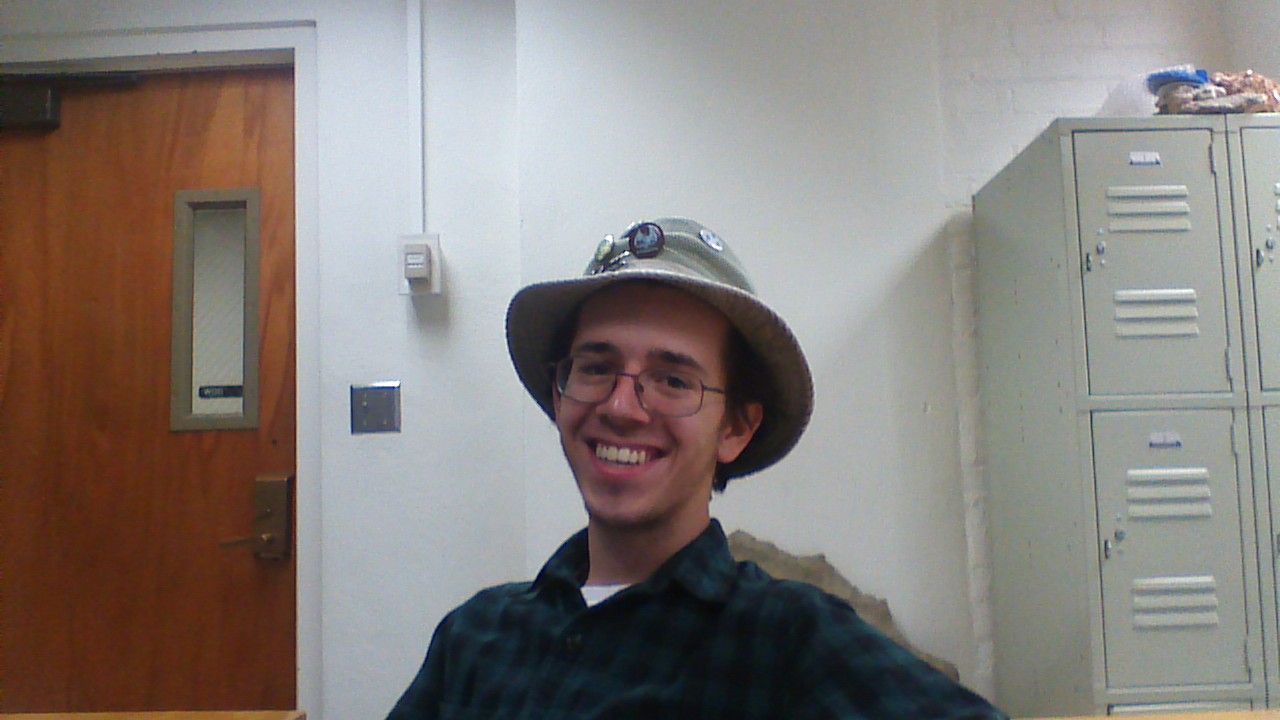
Andrew Connolly
M.S.
Education
B.S. Geology, University of Kansas, 2012
Advisor
Dr. Stephen Hasiotis
Thesis Title
Exploring the Relationship Between Paleobiogeography, Deep-Diving Behavior, and Size Variation of the Parietal Eye In Mosasaurs
Research
I am interested in the biogeographic range of Mosasaurs, as well as the paleobiogeographical effects of the parietal foramen in Mosasaurs and Permian reptiles.
Publications
Connolly, A.M., Martin, L.D., and Hasiotis, S.T., 2014, The paleobiogeographic effects of the parietal foramen on Mosasaurs. North American Paleontological Conference, Gainesville, FL, February 14-18, v.13, p. 21.
Connolly, A.M., Golab, J.A., Wolfe, B.A., Wildermuth, S., Jackson, A., Hammersburg, S.R., Jones, M., Goers, A., Fischer, S., Radar, R., Huber, M., Hogue, J., Moelling, L., Gabay, T., Dorward, B., Falk, A.R., Dzenowski, N., Raisanen, D., and Hasiotis, S.T., 2014, A new Ichnology Website at the University of Kansas (http://ichnology.ku.edu): A guide to identify trace fossils, interpret organism behaviors, and reconstruct paleoenvironments and paleoecosystems, and understand the stratigraphic record of behavior. North American Paleontological Conference, Gainesville, FL, February 14-18, v.13, p. 95.
Connolly, A.M., Golab, J.A., Wolfe, B.A., Wildermuth, S., Hammersburg, S.R., Dzenowski, N., Schmerge, J., Falk, A.R., and Hasiotis, S.T., 2013, From Abelichnus to Zoophycos: An online catalogue of ichnotaxa. Geological Society of America National Meeting, Denver, CO, October 27-30, v. 45(7), p. 325.
Connolly, A.M., Martin, L.D., and Hasiotis, S.T., 2013, The paleobiogeographical effects of the parietal foramen on mosasaurs. Geological Society of America National Meeting, Denver, CO, October 27-30, v. 45(7), p. 699.

John Counts
M.S.
Advisor
Dr. Stephen Hasiotis
Dissertation Title
Publications
Counts, J.W., and Hasiotis, S.T., 2013, Compound and cumulative paleosols in core from the Lower Permian (Asselian-Sakmarian) Council Grove Group of western Kansas: Implications of ichnofossil-rich paleosols developed in loess. Geological Society of America National Meeting, Denver, CO, October 27-30, v. 45(7), p. 699.
Counts, J. W. and Hasiotis, S. T., 2008. Backfilled meniscate burrows in Lower Permian (Wolfcampian) paleosols, Council Grove Group, western Kansas. Geological Society of America National Meeting, Houston, Texas, October 9, 1 p.
Counts, J. W. and Hasiotis, S. T., 2007. Neoichnology of scarab beetle larvae: modern analogs for backfilled trace fossils. North-central–South-central Geological Society of America Section Meeting, Lawrence, Kansas, 12 April, 1 p.
Counts, J. W. and Hasiotis, S. T., 2006. Ichnology of cyclothem deposits in the Lower Permian Council Grove Group. Geological Society of America Annual Meeting, Philadelphia, Abstracts with Program, v. 38, p. 435.

Kim Drager
Ph.D. Geology, The University of Kansas, 2015
Dissertation Title
Alterations of Fine and Coarse-Textured Soil Material Caused by the Ant Formica Subsericea
Publications
Drager, K., Hirmas, D., and Hasiotis, S.T., 2013, Effects of ant (Formica subsericea) bioturbation on soil physical and hydrological properties. Soil Science Society of America, Annual Meeting, Tampa, Florida, 1 p.

Justin Fairchild
M.S., The University of Kansas
Dissertation Title
Publications
Fairchild, J. M. and Hasiotis, S. T., 2007. Neoichnologic trackway experiments using the freshwater crayfish Orconectes. North-central–South-central Geological Society of America Section Meeting, Lawrence, Kansas, 13 April, 1 p.
Amanda Falk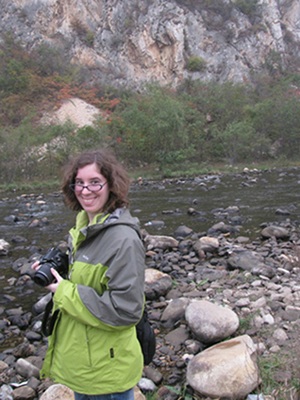
Ph.D.
Education
B.S. Biology, Lake Superior State University, 2007
M.S. Geology, University of Kansas, 2009
Advisors
Dr. Stephen Hasiotis
Dissertation Title
Anatomy and function of bird feet--the effect of behavior, medium and avian morphotype on trackway morphology
Research
I am interested in the tracks and traces of birds, both fossil and modern, as well as the general gross morphology and functional morphology of both fossil and ancient birds. I am also interested the evolution of avian migration, avian osteology, and the origin and evolution of birds. I also have minor interests in paleoecology and vertebrate anatomy (mainly in the functional morphology of animals other than birds). My current research focuses on analyzing the behaviors of Early Cretaceous bird tracks from the Haman Formation of South Korea, re-describing and interpreting bird tracks from several areas in China, as well as performing a series of morphologic measurements on the feet of fossil and modern birds to try and reconstruct soft tissue structures on the feet of Early Cretaceous fossil birds. I am also studying the behaviors and parameters under which modern bird tracks are produced.
Publications
Gong, E., Martin, L. D., Burnham, D. A., Falk, A. R., 2010. The birdlike raptor Sinornithosaurus was venomous. PNAS, v. 107(2), p. 766–768 (Cover paper).
Alexander, D. E., Gong, E., Martin, L. D., Burnham, D. A., Falk, A. R., 2010. Model tests of gliding with different hindwing configurations in the four-winged dromaeosaurid Microraptor gui. PNAS, v. 107(7), p. 2972–2976.
Falk, A. R., Hasiotis, S. T. and Martin, L.D., 2010. Feeding traces associated with bird tracks from the Lower Cretaceous Haman Formation, Republic of Korea. Palaois, v. 25, p. 730–741.
Falk, A. R. Tracking Mesozoic birds around the world. 2011. Journal of Systematic Palaeontology, v. 9(1) p. 85-90.
Falk, A. R., Martin, L.D. and Hasiotis, S. T., 2011. A morphologic criterion to distinguishing bird tracks. Journal of Ornithology, v. 152, p. 701–716.
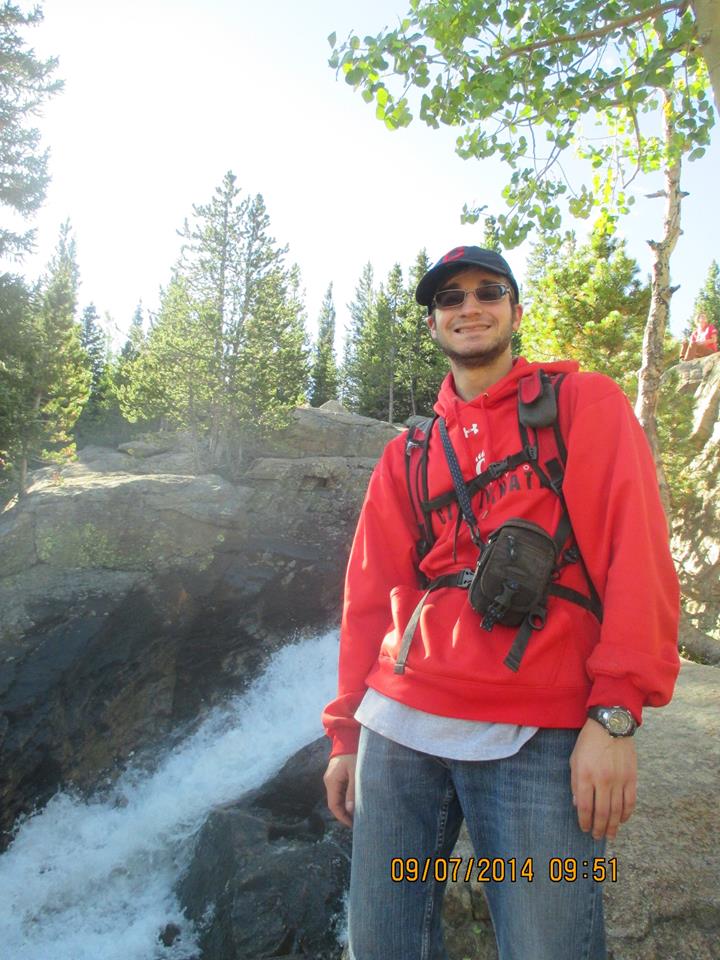
M.S.
Education
B.S. Geology, University of Cincinnati, 2013
Advisor
Dr. Stephen Hasiotis
Research
My project involves using ichnofossils and paleosols to investigate climate change during the deposition of the Upper Triassic Chinle Formation in Stevens Canyon, Utah. I am also interested in combining traces and paleosols into ichnopedofacies that will help in interpreting continental environments of deposition.
Publications
Hasiotis, S., Fischer, S., 2014. “New Interpretation for Very Large Diameter Burrows in the Petrified Forest Member, Upper Triassic Chinle Formation, Near Canyonlands National Park, Southeastern Utah: Therapsid Burrows?” Poster presentation, Geological Society of America Annual Meeting, Vancouver, British Columbia, Canada
Fischer, S., Hasiotis, S., 2014. “Preliminary Report on the Ichnopedofacies Associations in the Upper Triassic Chinle Formation, Stevens Canyon, Southeastern Utah: Evaluating Increasing Aridity Recorded During Chinle Deposition.” Poster presentation, Geological Society of America Annual Meeting, Vancouver, British Columbia, Canada
Fischer, S et al., 2012. “History of Heavy Metal Pollution in Cincinnati: Sediments in the Old Miami and Erie Canal.” Poster presentation, North Central Geological Society of America Conference, Dayton, Ohio.
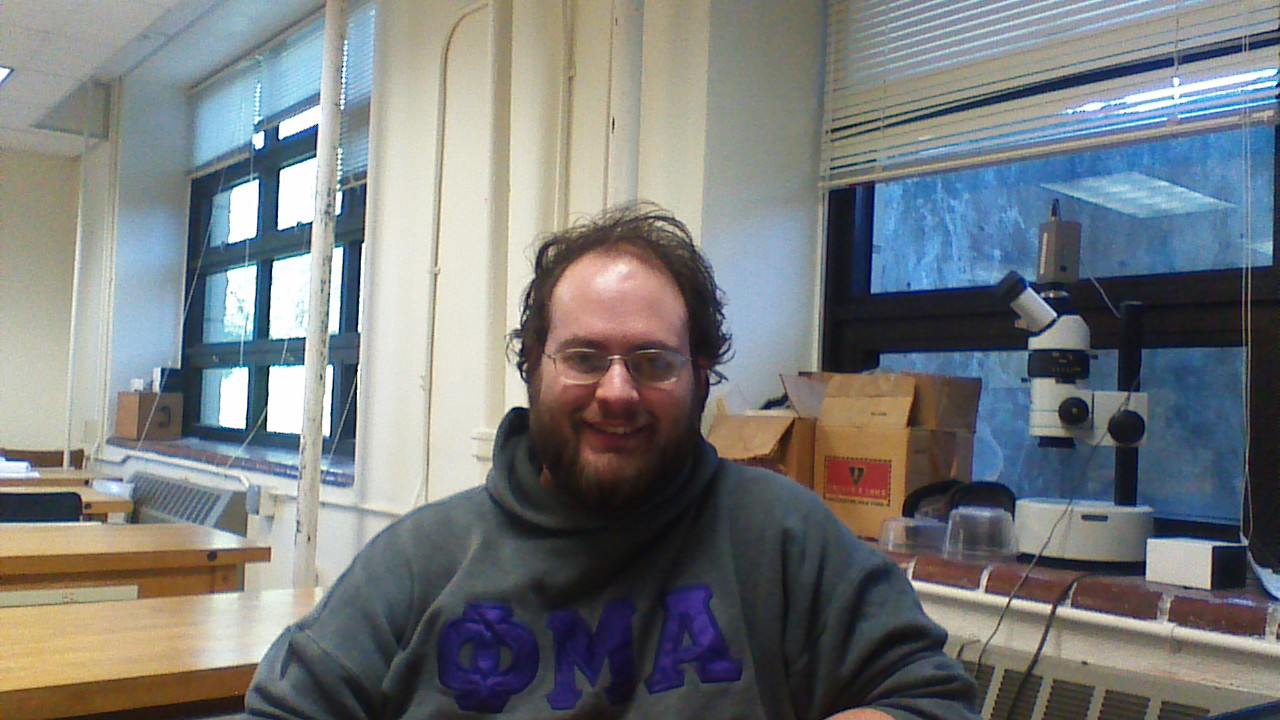
Sean Hammersburg
M.S.
Education
B.S. Geology, Central Michigan University, 2011
Advisor
Dr. Stephen Hasiotis
Research
I am studying middle Cambrian marine trace fossils from the Spence Shale Member of the Langston Formation from the Wellsville Mountains, Utah.
Publications
Hammersburg, S.R., Hasiotis, S.T., Robison, Gunther, L., Gunther, V., and Jamison, P., 2013, The ichnotaxonomy of the Cambrian Spence Shale of Utah: Preliminary Results. Geological Society of America National Meeting, Denver, CO, October 27-30, v. 45(7), p. 328.
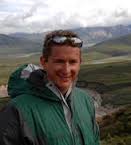
Daniel Hembree
Ph.D., The University of Kansas
Dissertation Title
Biogenic structures of modern and fossil continental organisms using trace fossil morphology to interpret paleoenvironment, paleoecology, and paleoclimate
Publications
Hembree, D. I., and Hasiotis, S. T., 2004. Casts of Modern Continental Burrows as Trace Fossil Analogs for Reconstructing Paleoenvironment and Paleoclimate. American Association of Petroleum Geologists National Meeting, Dallas, Texas, 1 p.
Hembree, D. I., and Hasiotis, S. T., 2004. Using paleosols and ichnofossils to interpret the changing paleoecology, paleoenvironments, and paleoclimate of the Eocene-Oligocene White River Formation, Colorado. Geological Society of America National Meeting, Denver, Colorado, 1 p.
Hembree, D. I., and Hasiotis, S. T., 2003. The fossil record and paleoecological significance of North American reptiles and their burrows: the interaction of fossorial reptiles with the substrate. Geological Society of America Annual Meeting, Abstracts with Programs, Seattle, Washington, v. 34(7), p. 499.
Hembree, D. I., Martin, L., and Hasiotis, S. T., 2003. Continental amphibian burrows from the Lower Permian Speiser Shale of Kansas, USA: Evidence for drought-induced aestivation in Permian tetrapods. Society of Vertebrate Paleontology 63rd Annual Meeting, October 15-18, 2003, St. Paul, Minnesota, 1 p.
Hembree, D. I., and Hasiotis, S. T. 2006. The identification and interpretation of reptile ichnofossils in paleosols through modern studies. Journal of Sedimentary Research, v. 76, p. 575-588.
Hembree, D. I., and Hasiotis, S. T. 2007. Biogenic structures produced by the Kenyan sand boa Eryx colubrinus (Reptilia: Ophidia: Boidae): modern analog for interpreting continental trace fossils. Journal of Sedimentary Research, v. 77, p. 389-397.
Hembree, D. I., and Hasiotis, S. T. 2007. Paleosols and ichnofossils of the White River Formation of Colorado: Insight into soil ecosystems of the North American midcontinent during the Eocene-Oligocene transition. PALAIOS v. 22, p. 123-142.
Hembree, D. I., and Hasiotis, S. T., 2008. Miocene Vertebrate and Invertebrate Burrows Defining Compound Paleosols in the Pawnee Creek Formation, Colorado, U.S.A. Palaeogeography, Palaeoclimatology, Palaeoecology, v. 270, p. 349-365.
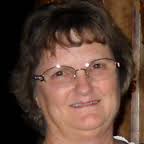
Debra Jennings
M.S., The University of Kansas
Dissertation Title
A paleoenvironmental analysis of Morrison Formation deposits, Big Horn Basin, Wyoming: A multivariate approach
Publications
Jennings, D., Santucci, V. L. , Buchheim, P. H., and Hasiotis, S. T., 2002. A preliminary inventory and assessment of ichnofossils from the Green River Formation. Geological Society of America Abstracts with Program, v. 34(6), p. 1.
Jennings, D. J., Platt, B. F., and Hasiotis, S. T. 2006. Distribution of vertebrate trace fossils, Upper Jurassic Morrison Formation, Bighorn Basin, Wyoming: implications for differentiating paleoecological partitioning and preservational bias. In Foster, J. (ed.), The Morrison Formation, New Mexico Museum of Natural History Bulletin 36, p.183-192.
Jennings, D. J. and Hasiotis, S. T. 2006. Paleoenvironmental and stratigraphic implications of authigenic clay distributions in Morrison Formation deposits, Bighorn Basin, Wyoming. In Foster, J. (ed.), The Morrison Formation, New Mexico Museum of Natural History Bulletin 36, 25-34.
Jennings, D. J. and Hasiotis, S. T. 2006. Taphonomic analysis of a dinosaur feeding site using Geographic Information Systems (GIS), Morrison Formation, southern Bighorn Basin, Wyoming, USA. PALAIOS, v. 27, p. 480-492.
Matt Jones

M.S., The University of Kansas
Education
B.S. Biology, University of Kansas, 2007
Advisor
Dr. Stephen Hasiotis
Dr. Larry Martin
Thesis Title
Neoichnology of Bats: Implications for pterosaur locomotion
Research
I am interested in studying the tracks and trackways produced by bats in order to establish a database of potential bat traces to be found in the rock record. The possibility of bat tracks and trackways in the rock record will greatly expand our understanding of bat evolution and paleobiogeography. I will also use tracks and trackways produced by bats as a modern analog for pterosaur ichnofossils, such as Pteraichnus and Haenamichnus, in order to better understand pterosaur ecology.
Publications
Jones, M.F., and Hasiotis, S.T., 2015. Preliminary Analysis of the Terrestrial Abilities of Bats in the Families Emballonuridae and Vespertilionidae. 45th Annual Symposium on Bat Research, Monterey, CA on Oct 28-31, 1 p.
Jones, M.F., and Hasiotis, S.T., 2012. Preliminary report on the trackway-making ability of bats (Phyllostomidae, Carollinae). Annual Meeting Geological Society of America, Charlotte, North Carolina, USA.
York, H. A., P. F. Foster, M. F. Jones, W. H. Schwarz, A. L. Vezeau, and M. S. Zerwekh. 2008. Observations of cavity-roosting behavior in Costa Rican Lophostoma brasiliense (Chiroptera: Phyllostomidae). Mammalian Biology 73: 230-232.
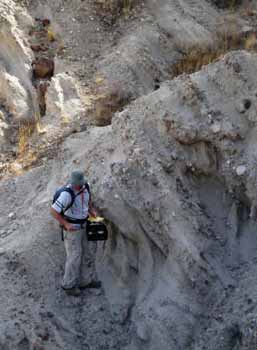
David LoBue
M.S., The University of Kansas, 2010
Dissertation Title
Ichnotaxonomic Assessment of Mazon Creek Area Trace Fossils, Illinois, USA
Publications
LoBue, D. and Hasiotis, S. T., 2007. Neoichnological study of the turtle Sternotherus odertus trackways. North-central–South-central Geological Society of America Section Meeting, Lawrence, Kansas, 12 April, 1 p.

Kim Montague
M.S., The University of Kansas, 2012
Dissertation Title
Publications
Montague, K. E., Hasiotis, S. T., and Walton, A.A., 2007. Endolithic microborings in basalt glass fragments in hyaloclastites: extending the ichnofabric index to microbioerosion. North-central–South-central Geological Society of America Section Meeting, Lawrence, Kansas, 13 April, 1 p.
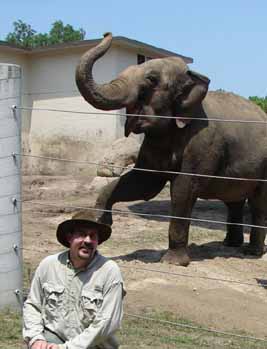
Brian Platt
Ph.D.
Education
B.S. Geology, Bloomsburg University of Pennsylvania, 2001
M.S. Paleontology, University of Kansas, 2005
Advisor
Dr. Stephen Hasiotis
Dissertaton Title
Quantification of paleoecological, paleohydrological, and
paleoclimatological information from the Upper Jurassic
Morrison Formation
Research
I have diverse interests in the field of ichnology, unified
by the overarching research goal of interpreting
paleoenvironments, paleoclimate, and paleoecology. I am
particularly interested in integrating new approaches and
quantitative technologies with traditional ichnological
methods. One aspect of my research focuses on how
sedimentary and physicochemical variables influence
megafaunal track formation and preservation; for this
project I am conducting trackmaking experiments with
elephants as modern analogs for sauropod dinosaurs. My goal
is to develop a method for quantifying ancient sediment
moisture and soil moisture from fossil megafaunal
footprints. I am also integrating ichnology, paleopedology,
and geochemistry to interpret paleoclimate of the Upper
Jurassic Morrison Formation. My goal is to look for
correlations between paleoclimatic and biotic patterns that
would suggest climatic influence on paleoecology. Another
of my projects has the goal of introducing novel
quantitative measures of trace fossils and modern traces
with new 3D laser scanning technology; this will improve
interpretations of trace fossils and facilitate enhanced
statistical and ichnotaxonomic studies.
Publications
Hasiotis, S.T., Reilly, M., Amos, K., Lang, S., Kennedy,
D., Todd, J.A., Michel, E., and Platt, B.F., in press,
Actualistic studies of the spatial and temporal
distributions of terrestrial and aquatic organism traces in
continental environments to differentiate lacustrine from
fluvial, eolian, and marine deposits in the geologic
record, in Baganz, O W., Bartov, Y., Bohacs, K., and
Nummendal, D., eds., Lacustrine sandstone reservoirs and
hydrocarbon systems: AAPG Memoir 95, 56 p.
Platt, B.F., and Hasiotis, S.T., 2011. Network analysis of the dinosaur-dominated ecosystem of the Upper Jurassic Morrison Formation, Western Interior North America. Geological Society of America Annual Meeting Minneapolis, MN. GSA Abstracts with Programs, v. 43, p. 380.
Platt, B.F., Hasiotis, S.T., and Hirmas, D.R., 2010. Use of
low-cost multistripe laser triangulation (MLT) scanning
technology for three-dimensional, quantitative
paleoichnological and neoichnological studies, Journal of
Sedimentary Research, v. 80, p. 590-610 (journal cover).
Platt, B.F., 2009. Review of Bonebeds, edited by Rogers,
R.R., Eberth, D.A., and Fiorillo, A.R., PALAIOS, DOI:
10.2110/palo.2009.BR48.
Platt, B.F., Hirmas, D.R. and Hasiotis, S.T. 2009. Footprints in the landscape: Quantifying bioturbation in soils and paleosols with multistripe laser triangulation (MLT) technology. In Abstracts, International Annual Meeting, ASA-CSSA-SSSA, Pittsburgh, PA. 1-4 Nov.
Platt, B.F., and Hasiotis, S.T., 2008. A new system for
describing and classifying tetrapod-tail traces with
implications for interpreting the dinosaur-tail trace
record, PALAIOS, v. 23, p. 3–13.
Platt, B.F., and Hasiotis, S. T., 2008. Modern elephant footprints in alluvium as analogs for sauropod dinosaur tracks in ancient floodplain sediments. Geological Society of America National Meeting, Houston, Texas, October 5, 1 p.
Platt, B., and Hasiotis, S. T., 2007. Track-making behavior of modern elephants as an analog for footprint formation by sauropod dinosaurs. North-central–South-central Geological Society of America Section Meeting, Lawrence, Kansas, 12 April, 1 p.
Hasiotis, S.T., Platt, B.F., Hembree, D.I., and Everhart,
M.J., 2007. The trace-fossil record of vertebrates, in
Miller, W. III, ed., Trace Fossils: Concepts, Problems, and
Prospects, Elsevier Press, p. 196–218.
Platt, B. F., and Hasiotis, S.T., 2006. Neoichnological experiments with modern elephants to quantify properties of megafaunal footprint formation: preliminary results, Geological Society of America Abstracts with Programs, v. 38, no. 7, p. 537.
Platt, B. F., and Hasiotis, S. T., 2006. New sauropod tracks with pad and skin impressions from the Upper Jurassic Morrison Formation, Big Horn basin, Wyoming. PALAIOS, v. 27, p. 249-261.
Platt, B. F., and Hasiotis, S. T., 2005. Bioturbation without a trace: the loss of ichnological diversity from propedisotropic processes in paleosols of the Upper Jurassic Morrison Formation, Big Horn Basin, Wyoming. American Association of Petroleum Geologists Annual Meeting, Calgary, Alberta, Canada, 1 p.
Platt, B. F., Hasiotis, S. T., and Kvale, E., 2004. A new theropod trackway with an associated tail trace from the Upper Jurassic Morrison Formation, Bighorn Basin, Wyoming, USA. Geological Society of America National Meeting, Denver, Colorado, 1 p.
Platt, B. F., and Hasiotis, S. T., 2004. Integrating ichnofossils and substrates to interpret avulsion in floodplain deposits in the Upper Jurassic Morrison Formation, Big Horn Basin, Wyoming. American Association of Petroleum Geologists National Meeting, Dallas, Texas, 1 p.
Platt, B. F., and Hasiotis, S. T., 2003. Vertebrate and invertebrate trace fossils in the Upper Jurassic Morrison Formation, Big Horn basin, Wyoming: linking ichnofossils and substrates in avulsion and floodplain deposits. Geological Society of America Annual Meeting, Abstracts with Programs, Seattle, Washington, v. 34(7), p. 498.

Julie Retrum
M.S., The University of Kansas, 2004
Dissertation Title
Early Permian Carbonitidae (Ostracoda, Crustacea): Ontogeny, Affinity, and Systematics
Publications
Retrum, J. B., Hasiotis, S. T., and Kaesler, R. L., 2005. Neoichnological experiments with freshwater ostracodes. Geological Society of America National Meeting, Salt Lake City, Abstracts with Program, v. 37(7), p. 443.

David Riese
M.S., The University of Kansas, 2011
Dissertation Title
Comparison of architectural and surficial burrow morphologies within and between fossil and extant vertebrates to aid in identification of fossil vertebrate burrows.
Publications
Riese, D.J., and Hasiotis, S.T., 2010, Comparison of architectural and surficial burrow morphologies within and between fossil and extant vertebrates to aid in identification of fossil vertebrate burrows. Geological Society of America National Meeting, Abstracts with Programs, p. 1.
Riese, D.J., Schmerge, J., and Hasiotis, S.T., 2009. The neoichnology of vinegaroons. Geological Society of America Abstracts with Program, Portland, Oregon, v. 41(7), p. 262.
Schmerge, J., Riese, D.J., Hasiotis, S.T., 2009. Neoichnological experiments with vinegaroons and implications for recognition of depositional environments: American Association of Petroleum Geologists, Annual Convention and Exhibition, June 7–10, Denver, Colorado, abstract volume
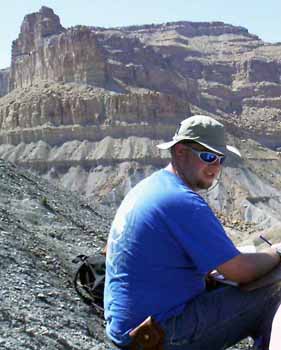
Joshua Schmerge
Ph.D.
Education
B.S. Geology, University of Wyoming, 2007
M.S. Geology, University of Kansas, 2011
Advisors
Dr. Stephen Hasiotis
Dissertation Title
A statistical examination of the change in
body size of mammalian communities across the
Eocene-Oligocene Boundary near Douglas, Wyoming
Research
I am most interested in how global climate change affects
the evolution of mammals. For my thesis, I have been
studying the evolution of the mammalian fauna in the White
River Formation during the Eocene-Oligocene transition.
Global climate cooled dramatically at this time, so I use
the well-documented fauna of the White River Formation to
test hypotheses about the effect of climate change on
mammalian body size. I have collected body size data from
fossil mammals from the both the Eocene and Oligocene and
compared them statistically (chi-square testing) to
determine if the overall body size is different between the
two epochs. My work on this project has also required the
application of ichnology and paleopedology as I have
reconstructed the paleoecology and paleoclimate of my field
area.
I am also interested studying fossil trackways with the aim
of interpreting paleoecology and paleohydrology. I am
currently working on a project with Dave Riese and Dr.
Hasiotis on the trackways of vinegaroons. Studying the
quality of preservation in experimentally produced
trackways allows us to see how trackway morphology changes
as sediment and moisture change.

Jon Smith
Dissertation Title
Ichnofossils of the Paleogene Willwood Formation and the Paleocene-Eocene Thermal Maximum (PETM): Response of an Ancient Soil Ecosystem to Transient Global Warming